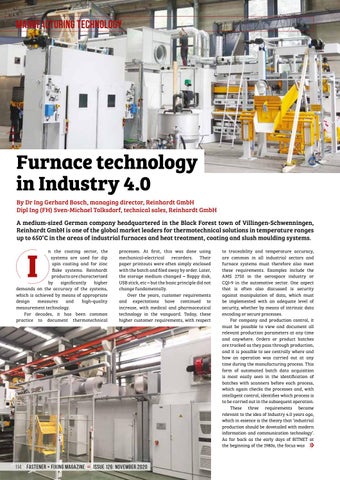MANUFACTURING TECHNOLOGY
Furnace technology in Industry 4.0 By Dr Ing Gerhard Bosch, managing director, Reinhardt GmbH Dipl Ing (FH) Sven-Michael Tolksdorf, technical sales, Reinhardt GmbH A medium-sized German company headquartered in the Black Forest town of Villingen-Schwenningen, Reinhardt GmbH is one of the global market leaders for thermotechnical solutions in temperature ranges up to 650°C in the areas of industrial furnaces and heat treatment, coating and slush moulding systems.
I
n the coating sector, the systems are used for dip spin coating and for zinc flake systems. Reinhardt products are characterised by significantly higher demands on the accuracy of the systems, which is achieved by means of appropriate design measures and high-quality measurement technology. For decades, it has been common practice to document thermotechnical
processes. At first, this was done using mechanical-electrical recorders. Their paper printouts were often simply enclosed with the batch and filed away by order. Later, the storage medium changed – floppy disk, USB stick, etc – but the basic principle did not change fundamentally. Over the years, customer requirements and expectations have continued to increase, with medical and pharmaceutical technology in the vanguard. Today, these higher customer requirements, with respect
114 FASTENER + FIXING MAGAZINE ≡ ISSUE 126: NOVEMBER 2020
to traceability and temperature accuracy, are common in all industrial sectors and furnace systems must therefore also meet these requirements. Examples include the AMS 2750 in the aerospace industry or CQI-9 in the automotive sector. One aspect that is often also discussed is security against manipulation of data, which must be implemented with an adequate level of security, whether by means of intrinsic data encoding or secure processes. For company and production control, it must be possible to view and document all relevant production parameters at any time and anywhere. Orders or product batches are tracked as they pass through production, and it is possible to see centrally where and how an operation was carried out at any time during the manufacturing process. This form of automated batch data acquisition is most easily seen in the identification of batches with scanners before each process, which again checks the processes and, with intelligent control, identifies which process is to be carried out in the subsequent operation. These three requirements became relevant to the idea of Industry 4.0 years ago, which in essence is the theory that ‘industrial production should be dovetailed with modern information and communication technology’. As far back as the early days of BITNET at the beginning of the 1980s, the focus was
